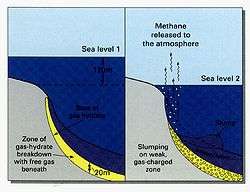Methane chimney

A methane chimney or gas chimney is a rising column of natural gas, mainly methane within a water or sediment column. The contrast in physical properties between the gas phase and the surrounding water makes such chimneys visible in oceanographic and geophysical data. In some cases, gas bubbles released at the seafloor may dissolve before they reach the ocean surface, but the increased hydrocarbon concentration may still be measured by chemical oceanographic techniques.
Identification
In some locations along Russia’s northern coast, methane rising from the sea floor to the surface has caused the sea to foam.[1] However, most methane chimneys do not produce such visible signs at the sea surface. Instead, plumes are identified by a combination of chemical and physical oceanographic and geologic data.[2] Plumes of methane bubbles, whether in the water column or subseafloor sediments, have lower density and sound speed than the surrounding water. As such, these plumes can be imaged by a variety of acoustic techniques, including seismic reflection data and conventional fishfinders. Dissolved methane is usually identified through widespread chemical analysis of water samples, including gas chromatography of gasses extracted from the headspace of seawater samples taken at depth (headspace is the space above a sample in a sealed container, which forms as higher temperature and lower pressure allows gasses to come out of solution). Continuous measurements of methane concentration in seawater can be made by underway ships using cavity ring-down spectroscopy.
Association with climate change
Large deposits of frozen methane, when thawing, release gas into the environment.[3] In cases of sub-sea permafrost, the methane gas may be dissolved in the seawater before reaching the surface. However, in a number of sites around the world, these methane chimneys release the gas directly into the atmosphere, contributing to global warming.[4]
Petroleum provinces
In hydrocarbon exploration, gas chimneys revealed on seismic reflection data are indicators of active gas migration[5] and a working petroleum system.
Trees as methane chimneys
Trees in swampy, low-laying areas can conduct methane produced in soils up through their stems and out their leaves. Other plants in bogs and marshes also act in this way. This accounts for approximately 60 teragrams, or about 10% of global annual production.[6]
Known sites
- North coast of Russia
- Golfo Dulce, Costa Rica
- Bering Sea[7]
- Northern coast of Siberia[8]
- Gulf of Cadiz[9]
See also
- Clathrate gun hypothesis
- Arctic methane release
- Methane clathrate
- Clathrate hydrate
- Runaway climate change
- Global warming
- Hydrothermal vent
References
- ↑ "Yale Environment 360: Numerous Methane `Chimneys'Discovered by Vessel in Russian Arctic". E360.yale.edu. 2008-09-23. Retrieved 2010-07-30.
- ↑ "Climate-Hydrate Interactions". usgs.gov. United States Geological Survey. Retrieved August 31, 2016.
- ↑ Connor, S. (23 September 2008). "Exclusive: The methane time bomb". The Independent. London. Retrieved 3 April 2010.
- ↑ "Oh Floe! Melting Ice Releases Millions of Tons of Methane Gas". Tressugar.com. 2008-09-24. Retrieved 2010-07-30.
- ↑ Schroot, B.M.; Schüttenhelm R.T.E. "Expressions of shallow gas in the Netherlands North Sea" (PDF). Netherlands Journal of Geosciences. 82 (1): 91–105. Retrieved 2010-04-03.
- ↑ "Trees: Another way to increase global methane? « Global Change". Globalchangeblog.com. 2010-02-01. Retrieved 2010-07-30.
- ↑ "Quantifying the Methane Content of Natural Gas and Gas Hydrate Accumulations in the Deep-Water Basins of the Bering Sea, by Ginger A. Barth, David W. Scholl, and Jonathan R. Childs; #90035 (2004)". Searchanddiscovery.net. Retrieved 2010-07-30.
- ↑ James Randerson, science correspondent (2008-09-23). "Methane release off Siberian coast prompts concern over runaway climate change | Environment | guardian.co.uk". London: Guardian. Retrieved 2010-07-30.
- ↑ Magalhães et al., (2012) Formation processes of methane-derived authigenic carbonates from theGulf of Cadiz. Sedimentary Geology, 243-244, pp.155-168.
External links
- IFM-GEOMAR, Kiel, DE Burning ice picture
- Methane Hydrates - discusses U.S. government funding of methane hydrates research
- Are there deposits of methane under the sea? Will global warming release the methane to the atmosphere?
- Methane seeps from Arctic sea bed
- Energy's Most Dangerous Game, Forbes magazine, 2 September 2008
- The Methane Time Bomb, The Independent, 23 September 2008
- Methane Hydrates: Natural Hazard or Natural Resource?